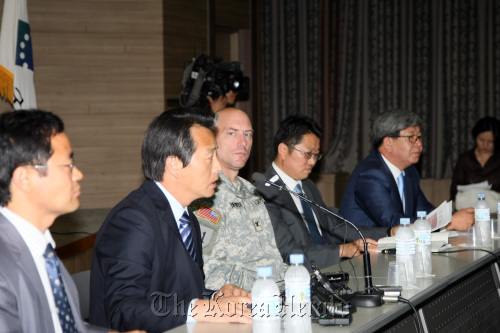Trace amounts of dioxin were found in streams near a U.S. military base where drums of Agent Orange were purportedly buried about three decades ago, a South Korea-U.S. probe team announced Thursday.
However, it said no dioxin was detected from samples of underground water taken from 10 tube wells located within 2 kilometers of Camp Carroll in Waegwan, North Gyeongsang Province, a key logistical support unit for U.S. troops here.
The team conducted the water-quality inspection in areas near the camp from May 27-31 following allegations by several former U.S. Forces Korea soldiers that a considerable amount of the defoliant was buried near the helipad of the camp in 1978.
 |
Professor Ok Kon of Pukyong National University announces the results of the probe into whether large amounts of defoliant were buried at Camp Carroll in Waegwan, North Gyeongsang Province, in 1978. (Yonhap News) |
Three of the 10 tube wells were used for drinking purposes while the rest were for non-potable use, officials said, pointing out that they analyzed the water according to 154 water quality criteria including 58 used to examine drinking water.
In the water samples taken from three of the six spots in the streams, the team found traces of dioxin ranging from 0.001 to 0.010 picograms per liter. One picogram equals one trillionth of a gram.
The amounts of the toxic chemical represent one three-thousandth to one thirty-thousandth of the standard for drinking water set by the U.S. Environmental Protection Agency, the team explained.
Environment Ministry officials involved in the inspection said that they needed to carry out additional environmental surveys as their findings were not enough to confirm whether the camp had been contaminated with the toxic chemical.
“Traces of dioxin could be detected after they were blown from somewhere else or they had already been accumulated in the soil there,” an official said, declining to be named.
“We should carry out an additional inspection to verify whether the dioxin found there was generated by the possible contamination from inside the base.”
Defoliants containing dioxin were used by the U.S. military to clear jungles for easier military operations during the Vietnam War.
In the late 1960s, the U.S. also sprayed strong herbicides including Agent Orange over the Demilitarized Zone dividing the two Koreas on a regular basis for easier detection of North Korean infiltrations.
The fat-soluble chemical causes or is linked to a broad range of human diseases including cancers, diabetes and birth defects. Chemical dioxins were developed in the U.S. in the late 1940s. They were initially used to clear plant life that clogged up irrigation canals.
The alleged dumping of Agent Orange at some of the U.S. installations here has prompted public calls for a full-scale environmental inspection of all U.S. military facilities in Korea as well as the 85 sites that the U.S. returned to the Seoul government between 1990 and 2003 without environmental surveys.
By Song Sang-ho (
sshluck@heraldcorp.com)








